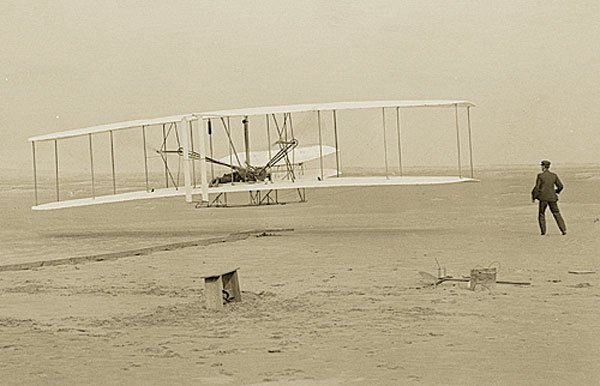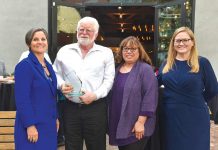Gazing upon the Wright Flyer replica kept in an exhibit shed at
the South County Airport’s Wings of History Air Museum, it’s a
wonder such an ungainly contraption might ever have gotten off the
ground.
Gazing upon the Wright Flyer replica kept in an exhibit shed at the South County Airport’s Wings of History Air Museum, it’s a wonder such an ungainly contraption might ever have gotten off the ground.
Orville and Wilbur Wright’s original airplane made its historic flight on Dec. 17, 1903.
It now hangs in a place of high honor in the National Air and Space Museum in Washington, D.C.
That pioneering airplane – like the exact full-scale facsimile in San Martin – was basically built out of sticks, wire, glue and linen cloth. It resembles an immense box kite.
The whole shebang was propelled through the air by a small gasoline engine less powerful than modern lawnmowers.
And yet, there’s something magical about that gawky-looking gizmo. It fulfilled a long-sought aspiration: To fly.
Human beings since at least the time of the Greek inventor Daedalus have dreamed of taking wing with the birds.
Geniuses such as Leonardo Da Vinci and Thomas Edison also took a stab at creating flying machines – including Da Vinci’s Renaissance version of the helicopter – and failed.
For centuries, experts kept insisting mechanical human flight was “impossible.”
But leave it to two brothers named Orville and Wilbur in the town of Dayton, Ohio, to come up with the manifestation of that dream. A mere century ago, their Wright Flyer took off against a 27-mile-an-hour Atlantic breeze on a desolate North Carolina beach called Kitty Hawk.
“The thing is, it was the first time that man was able to lift off and fly,” Wings of History docent Rocky Farano said of the two inventors’ moment of triumph.
Orville, the more outgoing of the two, was the first pilot. Wearing his business suit and wool cap, he laid belly down in the craft’s harness and reached out his arms to maneuver the crude rudder controls, Farano explained.
That first flight, both brother’s hearts must have pounded with elation as their machine rose into the air and sailed over sand for 120 feet. The length of today’s Boeing 747s is almost twice that distance.
The two Wrights had long held a hunger for manned flight. In their spare time, between fixing bicycles or serving customers at their Dayton bike shop, the young men read as much as they could about aviation engineering.
They invented the first wind tunnels to examine scale models of potential flying machine designs. They accidentally discovered the revolutionary principle of “wing warping” one day while playing with a bike inner tube box. A passion drove their pursuit.
And like the Wright brothers, Farano understands the ardent appeal of manned flight.
“At nine-years of age, I started building model airplanes – and it’s never ended,” the New York native said. As a teenager, he started to take flight lessons, taking off on a pontoon plane from the Hudson River before he ever learned to take off from an earth-bound runway strip. “I use to be the airport kid,” he said, recalling the days. “The go-fer kid.”
He moved to the South Valley in August 1990. The month after his arrival he joined the Wings of History Air Museum. He enjoys telling visitors the details of the museum’s unique and rare models of aircraft. Wandering through the extensive collection,Farano points out different planes and describes them as “home-built” models.
The 1970s Fly Baby 1-A came with folding wings (to store it easily in the garage). A plane called the “Deaf Duck” was built from plans sold over the mail by entrepreneur Volmer Jensen. A home-built “gyro-copter” looked like it came out of a James Bond movie.
The spirit of the Wright brothers permeates this place. The two inventors would certainly understand the various builders’ devotion to construct flying machine in their own garages in their spare time. That’s exactly how their Wright Flyer got built.
Farano also pointed out several commercially built historic planes. There was 3/4-scale replica of a 1913 Stahltaube – an early flying machine. The Steerman PT-17 Biplane was used by the Navy and Army during World War II at the Hollister airport to train pilots.
“It’s a very, very strong airplane,” Farano said of the Steerman, explaining how it needed to endure the not-so-soft landings of budding aviators. “These airplanes all have a history.”
Among the exhibits was 15-year-old Gilroy resident Philip Higgins.
Last week, as part of a field trip in Gilroy High School math teacher Peggy Branvold’s class, Higgins and other students had visited the airplane museum.
They came to understand the importance of mathematics in flight engineering. Philip felt so impressed that on Sunday, he brought his parents and brother Jonathan to the museum. Nearby Jonathan “flew” an exhibit simulator toward a computerized landing field of Skagway, Alaska.
“One of the docents said the Wright brothers didn’t graduate from high school,” Philip said. “They basically taught themselves … This inspires me to do my homework. We have opportunities now that weren’t there when the Wright brothers were around.”
Philip’s father Keith Higgins, the owner of a Gilroy-based civil engineering firm, also felt genuinely impressed by the museum’s unique airplane collection.
“I think it’s really amazing the ingenuity here – the people who took the airplane and made something unique out of it,” he said. Just then, the stall siren of the simulator blared. Jonathan tried to pull up, but the computerized plane plunged into the snowfield next to the runway.
It was a disaster Orville Wright had also experienced. One time, while demonstrating his invention to U.S. War Department officials, Orville’s also stalled and crashed, killing his sole passenger from a head fracture. The first airplane fatality. The dream of flight indeed has its perils.
In the 101 years since the Wright brothers’s first famous flight, human beings can now fly to virtually any point on the globe. They regularly travel faster than sound and in high space orbit. They have even flown to the Moon. The airplane changed politics and society in ways inconceivable in the millennia before its invention.
The airplane helped us to see a bird’s-eye view of our world, thus breaking down our self-imposed territorial mentality. For the first time, we saw the planet without boundaries – as one place in space.
Glance up at the South Valley sky on any clear night. Before too long, you’ll observe moving lights and hear the hum of engines overhead – perhaps a Boeing or a Beechcraft. For most of history, those “flying machines” would be an astonishing experience for virtually everyone.
For us in our modern world, it’s an every-day event most folks take for granted.
One hundred and one years ago today, Orville and Wilbur’s “impossible” invention first flew across the sands of Kitty Hawk. And from that moment on, the world was truly transformed by the Wright stuff.













